|
|
 |
|
Calanoida ( Order ) |
|
|
|
Bathypontioidea ( Superfamily ) |
|
|
|
Bathypontiidae ( Family ) |
|
|
|
Temorites ( Genus ) |
|
|
| |
Temorites brevis Sars, 1900 (F,M) | |
| | | | | | | Syn.: | ? Temoropsis simplex Wolfenden, 1911 (p.355, figs.M). | | | | Ref.: | | | Sars, 1900 (p.100, figs.F,M); Mrazek, 1902 (p.523); Sars, 1925 (p.194); Rose, 1933 a (p.171, figs.F,M); C.B. Wilson, 1950 (p.343, fig.F); Brodsky, 1950 (1967) (p.417, figs.F,M); Vervoort, 1957 (p.115, figs.F,M, Rem.); Tanaka, 1965 (p.384, figs.F,M, as T. brevipes); Vives, 1967 (p.551, fig.F); Vaupel-Klein, 1970 (p.4, 39); Vidal, 1971 a (p.14, 22, 110, figs.F,M); Shih & Laubitz, 1978 (p.50); Hure & Krsinic, 1998 (p.61, 101); Boxshall & Halsey, 2004 (p.73: figs.F,M); Vives & Shmeleva, 2007 (p.394, figs.F,M, Rem.); Blanco-Bercial & al., 2011 (p.103, Table 1, Biol. mol, phylogeny) | 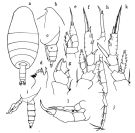 issued from : O. Tanaka in Publs Seto Mar. Biol. Lab., 1965, XII (5). [p.384, Fig.243]. As Temorites brevipes. Female: a, habitus (dorsal); b, forehead (left lateral side); c, last thoracic segment and urosome (left lateral side); d, masticatory edge of Md; e, P1; f, P2; g, basipods of P3; h, P5. Nota: The urosome segments and furca are in the proportional lengths as 40:22:18:11:9 = 100. A1 reaches back to the end of the genital somite. Male: i, last thoracic segment and urosome (left lateral side); j, clasping A1; k, right P2; l, P5. Nota: The urosome segments and furca are in the proportional lengths as 20:20:20:16:14:10 = 100.Grasping A1 on the right side.
|
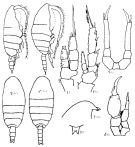 Issued from : K.A. Brodskii in Calanoida of the Far Eastern Seas and Polar Basin of the USSR. Opred. Fauna SSSR, 1950, 35 (Israel Program for Scientific Translations, Jerusalem, 1967) [p.417, Fig.295]. Female (from central part Arctic): habitus (dorsal andlateral right side): R, rostrum; forehead (lateral); S1, P1; S3, P3; S5, P5. Male: habitus (dorsal and lateral right side); S5, P5.
|
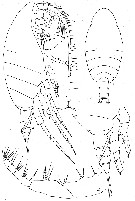 issued from : W. Vervoort in B.A.N.Z. Antarctic Reseach Expedition, Report-Ser. B, Vol. III, 1957 [Fig.102]. Female (from 61°44'S, 77°59'E): a, habitus (lateral); b, idem (dorsal, not at the same scale); c, posterior part cephalothorax and urosome (lateral); d, left Mxp.
|
 issued from : W. Vervoort in B.A.N.Z. Antarctic Reseach Expedition, Report-Ser. B, Vol. III, 1957 [Fig.103]. Female: a-b, right A1; c, Md (cutting edge); d, posterior part cephalothorax and urosome (dorsal); e, left Mx2.
|
 issued from : W. Vervoort in B.A.N.Z. Antarctic Reseach Expedition, Report-Ser. B, Vol. III, 1957 [Figs.104, 105]. Female: Fig. 104 (above]: a, left A2; b, left Mx1; c, Md (madibular palp). Fig.105 (below): a-d, P1 to P4 (left legs, posterior); e, P5.
|
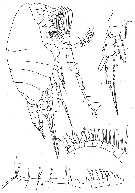 issued from : W. Vervoort in B.A.N.Z. Antarctic Reseach Expedition, Report-Ser. B, Vol. III, 1957 [Fig.106]. Male (from 64°55'S, 54°35'E): a, habitus (lateral); b, right P2 (anterior); c-d, right A1.
|
 issued from : W. Vervoort in B.A.N.Z. Antarctic Reseach Expedition, Report-Ser. B, Vol. III, 1957 [Fig.107]. Male: a, c, posterior part cephalothorax and urosome (lateral and dorsal, respectively); b, P5.
|
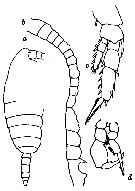 issued from : R.N. Wolfenden in Die Marinen Copepoden der Deutschen Südpolar-Expedition 1901-1903, 1911. [p.355, Fig.82]. As Temoropsis simplex With doubt. Male (from Antarctic, Indian sector): a, habitus (lateral); b, peoximal and medial portion of A1; c, P3; d, P5.
|
 issued from : R.N. Wolfenden in Die Marinen Copepoden der Deutschen Südpolar-Expedition 1901-1903, 1911. [Pl.XXXIX, Figs.8-14]. As Temoropsis simplex With doubt. Male (from Antarctic, Indian sector): 8, Mxp; 9, Mx2; 10, portion of seta of Mxp; ; 11, A2; 12, Md (mandibular palp); 13, P2; 14, P1.
|
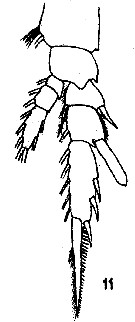 issued from : R.N. Wolfenden in Die Marinen Copepoden der Deutschen Südpolar-Expedition 1901-1903, 1911. [Pl.XXXVIII, Fig.11]. As Temoropsis simplex With doubt. Male: 11, P2.
|
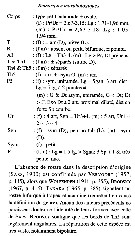 Issued from : C. Razouls in Ann. Inst. océanogr., Paris, 1994, 70 (1). [p.136]. Caractéristiques morphologiques de Temorites brevis femelle et mâle adultes. Terminologie et abbréviations: voir à Calanus propinquus.
| | | | | Compl. Ref.: | | | Damas & Koefoed, 1907 (p.400, tab.II); Sewell, 1948 (p.496, 502); Østvedt, 1955 (p.15: Table 3, p.71); Grice, 1962 a (p.101); M.W. Johnson, 1963 (p.89, Table 1, 2); Grice & Hulsemann, 1965 (p.225); Harding, 1966 (p.17, 65, 66); Grice & Hulsemann, 1967 (p.19); Dunbar & Harding, 1968 (p.319, 320); Roe, 1972 (p.277, tabl.1, tabl.2); Björnberg, 1973 (p.337, 389); Deevey & Brooks, 1977 (p.156, tab.2, Station "S"); Hure & al., 1980 (p.298); Vives, 1982 (p.295); Scotto di Carlo & al., 1984 (1045); Wiebe & al., 1988 (tab.7); Kosobokova, 1989 (p.26); Scotto di Carlo & al., 1991 (p.270); Mumm, 1993 (tab.1, fig.2); Shih & Young, 1995 (p.74); Kosobokova & al., 1998 (tab.2); Razouls & al., 2000 (p.343, tab. 5, Appendix); Kosobokova & Hirche, 2000 (p.2029, tab.2); Auel & Hagen, 2002 (p.1013, tab.2); Ringuette & al., 2002 (p.5081, Table 1); Vukanic, 2003 (139, tab.1); Hsiao & al., 2004 (p.325, tab.1: as Temorites brevipes); Deibel & Daly; 2007 (p.271, Table 1, Rem.: Arctic polynyas); Kosobokova & al., 2007 (p.919, Tab.2, fig.2); Blachowiak-Samolyk & al., 2007 (p.2716, Table 2); Blachowiak-Samolyk & al., 2008 (p.2210, Table 3, biomass); Schnack-Schiel & al., 2008 (p.1045: Tab.2); Galbraith, 2009 (pers. comm.); Licandro & Icardi, 2009 (p.17, Table 4); Park & Ferrari, 2009 (p.143, Table 4, Appendix 1, biogeography); Kosobokova & Hopcroft, 2010 (p.96, Table 1, fig.7); Homma & Yamaguchi, 2010 (p.965, Table 2); Mazzocchi & Di Capua, 2010 (p.424); Bucklin & al., 2010 (p.40, Table 1, Biol mol.); Dvoretsky & Dvoretsky, 2010 (p.991, Table 2); Kosobokova & al., 2011 (p.29, Table 2, figs.4, 8, Rem.: Arctic Basins); Homma & al., 2011 (p.29, Table 2, abundance, feeding pattern: suspension feeders); Belmonte, 2018 (p.273, Table I: Italian zones) | | | | NZ: | 15 | | |
|
Distribution map of Temorites brevis by geographical zones
|
| | | | | | | | | | | | | | | 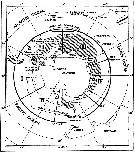 issued from : W. Vervoort in B.A.N.Z. Antarctic Reseach Expedition, Reports - Ser. B, Vol. III, 1957 [Fig.108] issued from : W. Vervoort in B.A.N.Z. Antarctic Reseach Expedition, Reports - Ser. B, Vol. III, 1957 [Fig.108]
Chart showing the geographical distribution (white circle) in the seas surrounding the Antarctic continent.
Nota: In this chart the area frequented by whaling vessels has been hatched. The Antarctic circle (66°.5 S) has been drawn as a broken line. The numbers I to VI refer to the sectors into which the Antarctic seas are divided according to Mackintosh (1942) (after Vervoort, 1951). |
| | | | Loc: | | | Antarct. (Peninsula, Weddell Sea, Indian, SW Pacif.), Ascension Is., off Mauritania, Canary Is., off Madeira, Sargasso Sea, off Bermuda (Station "S"); Spitzbergen, Fram Strait, Norwegian Sea, Barents Sea, Beaufort Sea, Arct. (Nansen Basin, Amundsen Basin, Makarov Basin, Laptev Sea, Lomonosov Ridge, Canadian abyssal plain, Fletcher's Ice Is., Canada Basin, Ellesmere Island, Chukchi Sea), Bering Sea ( S Aleutian Basin), Medit. (Alboran Sea, W Central Basin, Ligurian Sea, Tyrrhenian Sea, S Adriatic Sea, Ionian Sea), W Indian, Philippines, China Seas (South China Sea), Japan (Izu), Station "P", Vancouver Is., Guaymas Basin, N Chile | | | | N: | 50 | | | | Lg.: | | | (10) M: 1,6; (22) F: 2-1,8; M: 1,9-1,7; (25) F: 1,98-1,71; M: 1,94-1,8; (119) F: 1,71; M: 1,88; (134) F: 1,1; M: 1,05; (199) F: 1,9-1,52; M: 1,75; (1001) F: 2,12-1,88; {F: 1,10-2,12; M: 1,05-1,94} | | | | Rem.: | meso-bathypelagic.
Sampling depth (Antarct.): 200-1000 m. Sargasso Sea= 500-2000 m (Deevey & Brooks, 1977, Station "S"); | | | Last update : 05/02/2020 | |
|
|
 Any use of this site for a publication will be mentioned with the following reference : Any use of this site for a publication will be mentioned with the following reference :
Razouls C., Desreumaux N., Kouwenberg J. and de Bovée F., 2005-2025. - Biodiversity of Marine Planktonic Copepods (morphology, geographical distribution and biological data). Sorbonne University, CNRS. Available at http://copepodes.obs-banyuls.fr/en [Accessed December 25, 2025] © copyright 2005-2025 Sorbonne University, CNRS
|
|
 |
 |















